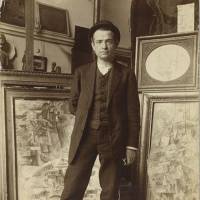(1882-1960)

Follow Auguste HERBIN
Auguste Herbin spent his childhood in Le Cateau-Cambrésis. He studied at the Academy of Fine Arts in Lille from 1898 to 1901 in Pharaon de Winter's studio, and later settled in Paris.
He initially painted in the post-impressionist style, which is evident in the canvases he submitted to the Salon des Indépendants in 1906.
He gradually moved towards Cubism after meeting Pablo Picasso and Georges Braque in 1909 at the Bateau-Lavoir in Paris. His friendship with the German art critic and collector Wilhelm Uhde also encouraged him in this direction. In 1910, at the Salon des Indépendants, he exhibited in the same room as Jean Metzinger, Albert Gleizes, and Fernand Léger, and in 1912, he participated in the important Section d'Or exhibition. During his time in Céret between 1913 and 1923, he created several Cubist works (such as "Paysage à Céret") and abandoned the concept of perspective.
During World War I, Herbin was assigned to decorate a military chapel at the Mailly-le-Camp camp and later worked on camouflage projects.
In 1917, Herbin produced his first abstract paintings. He was noticed by Léonce Rosenberg, who bought several of his paintings and signed him to a contract at the Galerie de L'Effort moderne in Paris, where he exhibited several times between 1918 and 1921. In 1919, Herbin decided to abandon Cubism, considering it outdated. His relief geometric wooden paintings challenged the traditional easel painting, but they were poorly received, even by Cubism supporters. Herbin retired to Le Cateau-Cambrésis. Between 1922 and 1925, he returned to a figurative style, influenced by Rosenberg's advice. Later, he disowned the landscapes, still lifes, and genre scenes from that period, in which he represented objects as simplified volumes. In 1929, he co-founded the Salon des Surindépendants.
In the 1940s and 1950s, Herbin invented his plastic alphabet based on synesthesia: a composition method that starts with a repertoire of 26 colors, each corresponding to a letter and geometric shapes (triangle, circle, semicircle, quadrilateral), as well as a musical note. For example, the letter "i" is associated with a circle and a triangle, the color orange, and the musical note "re." Herbin's paintings are based on a word that becomes the title of the painting, following correspondences between letters, shapes, colors, and musical sounds.
In 1946, Herbin developed his "Plastic Alphabet" and became the president of the Salon des Réalités Nouvelles. In 1949, he presented his book "L'Art non figuratif, non objectif" at the La Gentilhommière gallery in Paris, where he showcased his plastic alphabet. This book became a major reference in abstract painting of that era. The second generation of abstract artists, including Jean Dewasne, Victor Vasarely, Olle Baertling, Richard Mortensen, Robert Jacobsen, etc., considered him a master and received his teachings during conferences at the Atelier d'Art Abstrait, a place created by Jean Dewasne and Edgar Pillet, or during the Salon des Réalités Nouvelles. After World War II, he, along with Jean Arp and Alberto Magnelli, was the only living artist who witnessed the history of abstract art and contributed to its evolution.
In 1953, Herbin suffered a stroke. He relearned to paint with his left hand. His meeting with Guy de Lussigny in 1956 was decisive in the young painter's career. That same year, he donated 24 works to the City of Le Cateau-Cambrésis, creating a second collection for the museum established by Henri Matisse in 1952.
Since the 1960s and up to the present day, he has been represented in Paris by the Lahumière gallery and the Denise René gallery, which regularly exhibit his works.
The last retrospective of his work took place in 2013 at the Matisse Museum in Le Cateau-Cambrésis and the Museum of Modern Art in Céret.

Secure payment
3DSecure 2.2

Free DHL Express delivery from €1,200
Carefully prepared parcel
Parcel tracking

Shipment insured
for the value of the artwork, covering theft and damages

Fairest prices
Certificate of authenticity
Two galleries in Paris
Receive an email as soon as a new artwork is added for this artist
Your message has been sent ! We will get back to you as soon as possible.
Please fill in the form if you need further information such
Please fill in your email address, an email will be sent with a link to update your password.
You can now place orders and track your orders.
To save your wishlist, you can log in or create an account :